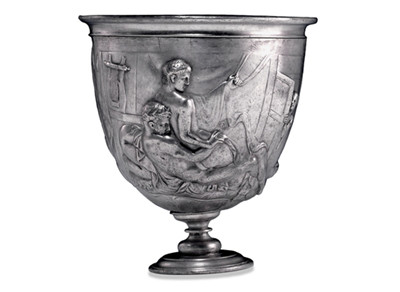"What you have on this cup are two different varieties of a homosexual act. On the front you've got an older man, and we know he's older because he's got a beard. Sitting astride him is a very handsome young man, it's all very vigorous and virile. This is kind of 'camera virite' if you like, I mean it's very realistic-this isn't an idealised view of homosexuality. What's quite interesting, if you go around the back, is here you've got something which is more a kind of standard portrayal of homosexuality; two very beautiful young men-we know that they're young because they've got locks of hair hanging down their backs-one is lying on his back, and the slightly older man is looking away. It's a lot more kind of lyrical, a rather idealised view of what homosexuality was."
银杯上刻画了两种不同的同性性爱。正面是一位有胡子的成年男性,身上跨坐着一位英俊少年。性爱的动作被刻画得阳刚有力,也十分逼真,但这并非理想化的同性性爱场景。不过如果你转到背面,便会看到一场更为标准的同性性爱。人物是两个英俊的青年男子:垂到背上的发缕表明他们还十分年轻。一人侧躺着,年纪稍大的那位则看向另一边。这是更抒情、更理想化的同性性爱场面。
Although the homosexual scenes on the cup are ones that today strike us as explicit-some might say shocking and taboo-homosexuality was very much part of Roman life. But it was a complicated part, tolerated but not entirely accepted. The standard Roman line on what was acceptable in same-sex coupling is neatly summarised by the Roman playwright Plautus in his comedy 'Curculio':
尽管杯子上的场景在今天看来过于露骨,甚至有些惊世骇俗,触犯了社会禁忌,但在当时的罗马却是十分平常。不过这里的情况有些复杂,社会虽能容忍,但并非人人都能接受。罗马剧作家普劳图斯的喜剧《象鼻虫》中有一段话,大致能概括当时罗马人对同性恋的态度:
"Love whatever you wish, as long as you stay away from married women, widows, virgins, young men and free boys."
“想爱谁就爱谁,只要不是已婚妇女、寡妇、处女、年轻男性和自由民男孩。”
So if you wanted to show sex between men and youths who weren't slaves, it made sense to look back to the age of Classical Greece, where it was normal for older men to teach younger free-born boys about life in general, in a mentoring relationship that included sex.
因此,如果你想要表现成年男性和非奴隶少年之间的性爱,把场景设置到古希腊时期会是个合适的选择,在古希腊,由成年男子教导少年如何生活是十分普遍的事,那是一种包含性行为在内的师生关系。













